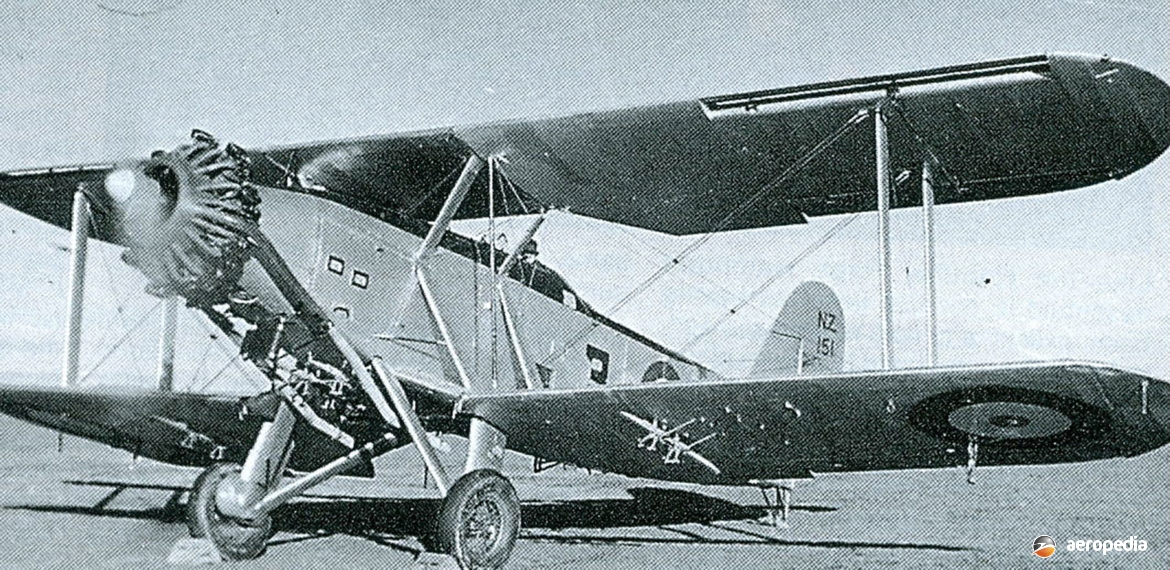Photograph:
Blackburn Baffin NZ151 at Ohakea, NZ (RNZAF Museum)
Country of origin:
United Kingdom
Description:
Two-seat carrier-borne torpedo bomber
Power Plant:
One 421 kw (565 hp) Bristol Pegasus I.M.3 nine-cylinder air-cooled radial engine
Specifications:
- Wingspan: 13.89 m (45 ft 6½ in)
- Length: 11.7 m (38 ft 3¾ in)
- Height: 4.11 m (13 ft 5½ in)
- Wing area: 60.2 m² (649 sq ft)
- Max speed at 1,524 m (5,000 ft): 219 km/h (136 mph)
- Max speed at sea level: 201 km/h (125 km/h)
- Rate of climb at sea level: 146 m/min (480 ft/min)
- Service ceiling: 4,572 m (15,000 ft)
- Range at 161 km/h (100 mph): 724 km (450 miles)
- Endurance: 4 ½ hrs
- Empty weight: 1,896 kg (4,180 lb)
- Loaded weight: 3,452 kg (7,610 lb)
Armament:
One fixed 7.7 mm (0.303 in) Lewis machine gun firing forward; one 7.7 mm (0.303 in) Lewis machine gun on mounting aft; provision for 715 kg (1,576 lb) Mk VIII or Mk X torpedo or one 907 kg (2,000 lb) bomb; six 113 kg (250 lb) or three 240 kg (530 lb) bombs
History:
The Blackburn Baffin was designed by Major F A Bumpus to meet a Royal Navy Fleet Air Arm requirement, and was built by the Blackburn Aircraft & Motor Co Ltd of Brough in Yorkshire to succeed the Company’s Ripon as the standard torpedo bomber with the FAA for operation from that service’s carriers, introducing a Bristol Pegasus I.MS radial engine in lieu of the liquid-cooled Napier Lion used in the Ripon.
Although the Baffin offered only a marginally better performance than its predecessor, it saw service with the FAA with No 812 Squadron on board ‘HMS Glorious’, No 810 Squadron on board ‘HMS Courageous’, and No 811 Squadron on board ‘HMS Furious’, the first (No 812) receiving its first aircraft in January 1934, No 810 in August 1934 and No 811 in May 1935. The type only remained in service until December 1936, No 812 Squadron being the last unit to retain the type, the Baffin being replaced by the Fairey Swordfish and Blackburn Shark. In September 1937 it was declared obsolete.
Originally designated B-5, the type received the name ‘Baffin’ in September 1933, the prototype first flying on 30 September 1932, deliveries of the first production batch consisting of 15 aircraft (serials K3589, K3590, K4071 to K4080 inclusive, and K4776 to K4778 inclusive) commencing in the following year.
A total of 39 new-build aircraft was completed and, in addition, a total of 62 Ripons was converted to Baffin configuration, these retaining their original serial numbers. Two prototypes and 33 production Baffins were operated by the training flight at Gosport in Hampshire for dummy deck-landing and torpedo-dropping practice.
In 1937 a total of 29 Baffins was purchased by the New Zealand Government to equip the Territorial Air Force [Reserve] for coastal reconnaissance, being allocated to units in Auckland, Wellington and Christchurch. These aircraft (serials NZ150 to NZ178) had the torpedo equipment removed in the United Kingdom before shipment, the first four arriving in Auckland in November 1937 and the first (serial S1573) being test flown ten weeks later. First operational flights began on 16 November 1939.
The Wellington Territorial Squadron was the first unit equipped, receiving 12 aircraft in mid 1938, followed by the Christchurch Squadron, which received six. These aircraft first operated with Royal Navy Fleet Air Arm serials and did not receive the RNZAF serials until May 1939. Prior to the outbreak of war 24 were in service and were used in the training role but they were soon returned to active duties.
In March 1940 the survivors (20 aircraft) were flown to Hobsonville where they equipped the newly created General Reconnaissance Squadron, re-named No 1 GR Squadron in 1941. Later that year they were replaced by the Vickers Vildebeeste and were placed in storage at Harewood. In March 1941 they were used to equip No 3 General Reconnaissance Squadron and were used to patrol the approaches to Lyttelton Harbour. A flight was established to patrol the Otago approaches operating from Taieri.
By mid-1941 the survivors had been replaced and were ferried to Rongotai where they were reduced to scrap by the end of 1941. A number were converted for use as instructional airframes at training establishments, these including NZ159 (Inst 4), NZ166 (Inst 5), NZ150 (Inst 29), NZ168 (Inst 6), NZ172 (Inst 7), NZ175 (Inst 16), NZ153 (Inst 22), and NZ156 (Inst 19).
The substantial remains of one Baffin has been held in the Charles Darby collection in Auckland. Although the identity of this machine is not known, it is the last survivor of its type and enough components from various examples have been collected to form the basis of a complete restoration of a static example at some time in the future.
Work has commenced on the restoration of Baffin S1674 / NZ160 at Dairy Flat, this aircraft having ditched into Little Pigeon Bay, Banks Peninsula, on 10 May 1939 at Dairy Flat near Auckland. This aircraft, which was operating from Wigram at the time, force landed after engine problems and was recovered with some parts being salvaged.

